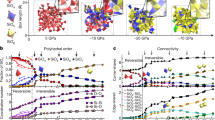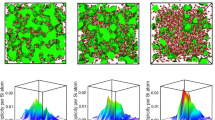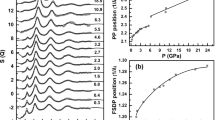Abstract
TO reproduce and predict crystal structures from first principles has been a longstanding problem in solid-state physics. We have recently shown1 that a first-principles many-body calculation for clusters can be used to extract effective pairwise interatomic potentials, which were then used in a molecular dynamics study of the stability of crystalline silica (SiO2). Here we use this approach in a molecular dynamics study of pressure-induced structural transitions at room temperature for various polymorphs of silica. We predict new structural transitions for low-quartz, low-cristobalite and coesite, in which some of the new phases, appearing without the occurrence of diffusion, comprise mixed arrays of fourfold and sixfold Si–O coordinations. Stishovite, the densest known polymorph of silica, persists up to 250 GPa, with deformation to the CaCl2 structure. Although a recent theoretical calculation predicts a possible polymorph denser than stishovite, which may be of importance in the Earth's interior2, this phase is not obtained by (simulated) compression of stishovite at room temperature, presumably because of the potential barrier between the two structures.
This is a preview of subscription content, access via your institution
Access options
Subscribe to this journal
Receive 51 print issues and online access
$199.00 per year
only $3.90 per issue
Buy this article
- Purchase on Springer Link
- Instant access to full article PDF
Prices may be subject to local taxes which are calculated during checkout
Similar content being viewed by others
References
Tsuneyuki, S., Tsukada, M., Aoki, H. & Matsui, Y. Phys. Rev. Lett. 61, 869–872 (1988).
Park, K. T., Terakura, K. & Matsui, Y. Nature 336, 670–672 (1988).
Holm, J. L. & Kleppa, O. J. Inorg. Chem. 6, 645–648 (1967).
Wise, S. S., Margrave, J. L., Feder, H. M. & Hubbard, W. N. Phys. Chem. 66, 381 (1962).
Parrinello, M. & Rahman, A. J. appl. Phys. 52, 7182–7190 (1981).
Nosé, S. J. chem. Phys. 81, 511–519 (1984).
Hemley, R. J., Jephcoat, A. P., Mao, H. K., Ming, L. C. & Manghnani, M. H. Nature 334, 52–54 (1988).
Stolper, E. M. & Ahrens, T. J. Geophys. Res. Lett. 14, 1231–1233 (1988).
Matsui, Y. & Kawamura, K. in High Pressure Research in Mineral Physics (eds Manghnani, M. H. & Syono, Y.) Geophysical Monograph 39 (American Geophysical Union, Washington DC), 305–311 (1987).
Williams, Q. & Jeanloz, R. Science 239, 902–905 (1988).
Tsuchida, Y. & Yagi, T. preprint, Tech. Rep. of ISSP, University of Tokyo, Ser. A No. 2099 (1989).
Hemley, R. J. in High Pressure Research in Mineral Physics (eds Manghnani, M. H. & Syono, Y.) Geophysical Monograph 39 (American Geophysical Union, Washington, DC) 347–359 (1987).
Author information
Authors and Affiliations
Rights and permissions
About this article
Cite this article
Tsuneyuki, S., Matsui, Y., Aoki, H. et al. New pressure-induced structural transformations in silica obtained by computer simulation. Nature 339, 209–211 (1989). https://doi.org/10.1038/339209a0
Received:
Accepted:
Issue Date:
DOI: https://doi.org/10.1038/339209a0
This article is cited by
-
First-principles calculations of elasticity of minerals at high temperature and pressure
Science China Earth Sciences (2016)
-
Anomalous behavior of cristobalite in helium under high pressure
Physics and Chemistry of Minerals (2013)
-
New insights into the high-pressure polymorphism of SiO2 cristobalite
Physics and Chemistry of Minerals (2011)
-
Molecular simulations of clay minerals: a study considering the change of cell size and shape
Acta Geotechnica (2010)
-
Six-fold-coordinated phosphorus by oxygen in AlPO4 quartz homeotype under high pressure
Nature Materials (2007)
Comments
By submitting a comment you agree to abide by our Terms and Community Guidelines. If you find something abusive or that does not comply with our terms or guidelines please flag it as inappropriate.



